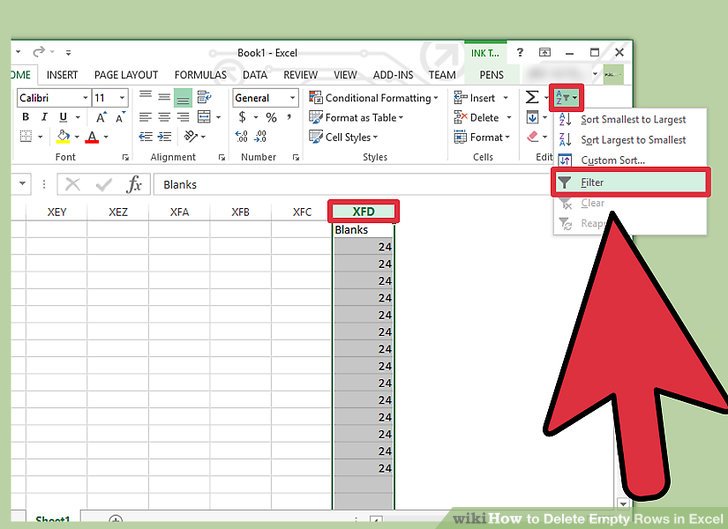Tame Your Data: Conquer Blank Rows in Excel
Ever opened a sprawling Excel spreadsheet and felt overwhelmed by a sea of empty rows? Blank rows can clutter your data, making analysis difficult and formulas prone to errors. This guide provides a comprehensive overview of how to eliminate these pesky gaps and streamline your spreadsheets.
Dealing with blank rows is a common Excel challenge. They can arise from importing data from other sources, deleting cell contents without removing the entire row, or simply from human error. Regardless of the cause, they impede data analysis and can lead to inaccurate calculations. Learning how to efficiently manage and delete blank rows is essential for anyone working with Excel.
While the concept of deleting blank rows might seem straightforward, the specific method you choose depends on the complexity of your data and the frequency with which you need to perform this task. From simple sorting to utilizing advanced filtering techniques, Excel offers a range of options to cater to various needs. Understanding these options empowers you to choose the most efficient approach for your specific scenario.
The history of dealing with blank rows in Excel has evolved alongside the software itself. Early versions relied heavily on manual deletion, but as Excel's features expanded, more automated methods emerged. Today, users have access to a variety of tools, including Go To Special, filtering, and VBA scripting, allowing for faster and more efficient blank row removal.
Mastering the art of deleting blank rows is crucial for maintaining clean and efficient spreadsheets. It improves data readability, facilitates accurate calculations, and simplifies data analysis. By removing unnecessary rows, you can focus on the information that matters and gain valuable insights from your data.
Benefits of Removing Blank Rows:
1. Improved Readability: Concise spreadsheets are easier to understand and navigate. Removing empty rows eliminates visual clutter and makes it easier to identify trends and patterns in your data.
2. Accurate Calculations: Blank rows can interfere with formulas, leading to incorrect results. Removing them ensures accurate calculations and reliable data analysis.
3. Reduced File Size: Empty rows contribute to larger file sizes. Removing them can reduce file size, making sharing and storing your spreadsheets more efficient.
Step-by-Step Guide to Removing Blank Rows:
1. Select the Data Range: Highlight the entire data range containing the blank rows you want to remove.
2. Go To Special: Press F5 or Ctrl+G (Cmd+G on Mac) to open the Go To dialog box. Click "Special."
3. Select Blanks: Choose "Blanks" and click "OK."
4. Delete Rows: Right-click on one of the selected blank rows and choose "Delete" -> "Entire row".
Advantages and Disadvantages of Removing Blank Rows
| Advantages | Disadvantages |
|---|---|
| Improved data readability | Potential for accidental data deletion if not careful |
| Enhanced calculation accuracy | Time-consuming for very large datasets if using manual methods |
Best Practices:
1. Always back up your data before deleting rows.
2. Double-check the selected rows before deleting.
3. Use keyboard shortcuts for faster execution.
4. Consider using filters for complex scenarios.
5. Explore VBA scripting for automating the process.
Frequently Asked Questions:
1. Can I undo the deletion of blank rows? Yes, using Ctrl+Z (Cmd+Z on Mac).
2. What if my data has hidden rows? Unhide the rows before performing the deletion.
3. How do I delete rows based on blank cells in a specific column? Use filtering.
4. Is there a way to automate this process? Yes, with VBA scripting.
5. What if my spreadsheet is very large? Consider using filtering or VBA for efficiency.
6. How to delete blank rows in a specific range? Select the range before applying the Go To Special method.
7. Can I delete rows that contain only spaces? Yes, use the Find and Replace function to remove spaces before applying the blank row deletion method.
8. What if I accidentally delete data? Restore from your backup or use Ctrl+Z.
Tips and Tricks:
Use the `FILTER` function for a dynamic approach to hiding blank rows without deleting them.
Cleaning up your Excel spreadsheets by eliminating blank rows is a fundamental skill that significantly improves data management and analysis. From enhancing readability to ensuring accurate calculations, the benefits are substantial. While different methods exist, understanding the options available allows you to choose the most efficient approach for your specific needs. By mastering these techniques and implementing best practices, you can tame your data, boost your productivity, and gain valuable insights from your spreadsheets. Take control of your data today and experience the power of a clean and organized spreadsheet! Don't let blank rows hold you back – start streamlining your Excel workflows today.
Simplify your travel with the baggallini extra large carryall tote
The enduring allure and significance of mexican womens charro attire
Decoding ccc what does it mean and why should you care














